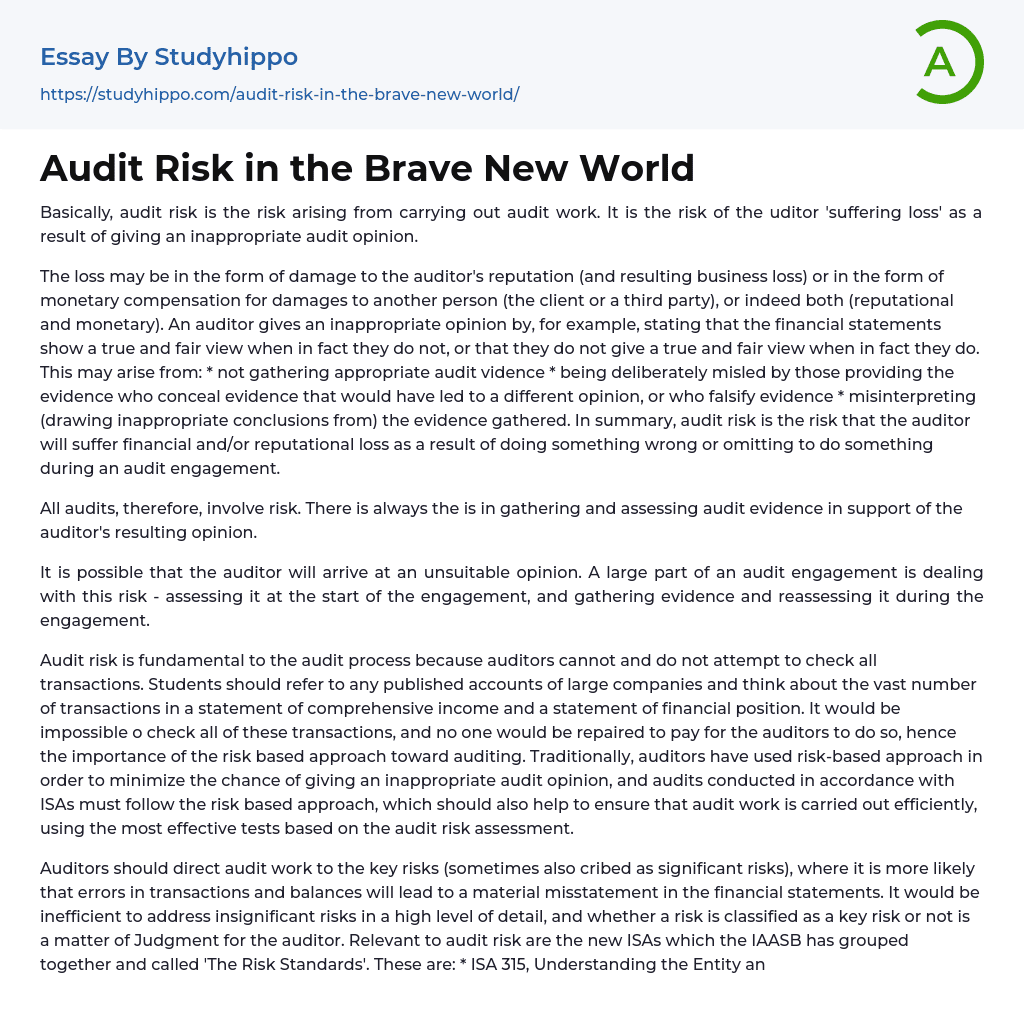Audit risk is the risk associated with conducting an audit, which refers to the possibility of the auditor experiencing a loss due to providing an inappropriate audit opinion. Such a loss can be in terms of the auditor's reputation or monetary compensation for damages to the client or a third party, or both. This can occur if the auditor fails to gather appropriate evidence, is misled by those providing the evidence, or misinterprets the gathered evidence. As a result, all audits involve risk, including the possibility of arriving at an unsuitable opinion, and require careful gathering and assessment of audit evidence.
Assessing and managing audit risk is a critical aspect of the audit engagement process, as auditors cannot realistically verify every transaction. To illustrate this point, students can examine large companies' published accounts and see the sheer volume of tran
...sactions within financial statements. Therefore, auditors adopt a risk-based approach to auditing in order to minimize the likelihood of issuing an improper audit opinion. This method requires auditors to direct their focus on significant or key risks where potential errors in transactions and balances may result in a material misstatement in financial statements. The classification of a risk as significant or not is a matter of the auditor's discretion. This approach ensures efficient audit work that employs effective tests based on the risk assessment and conforms to the ISAs standard. Throughout the engagement, auditors continually gather evidence and reassess risk to ensure proper management of audit risk.The IAASB has combined certain ISAs and named them 'The Risk Standards', which pertain to audit risk. These standards are ISA 315 for assessing risks of material misstatements and understandin
the entity and its environment, ISA 330 for auditor procedures in response to assessed risks, and ISA 500 (Revised) for audit evidence. The newly-issued risk standards bring significant changes to the financial statement audit standards, allowing auditors to focus more accurately on areas with a higher risk of financial statement misstatement. With better risk assessments through detailed understanding of the entity and its environment, internal control, and improved design and performance of audit procedures in response to identified risks of material misstatements, the quality of audits is expected to improve. The improved linkage between audit procedures and assessed risks can produce a greater focus on areas with a higher risk of material misstatements. The introduction to each standard outlines their respective scopes. For instance, ISA 315 provides guidance on performing audit procedures to acquire a better understanding of the entity and its environment, along with assessing risks of material misstatement in an organization.The IAASB recognizes that there are particular factors that must be taken into account when auditing small entities, which are addressed in ISA 31 5. Another related standard is ISA 330, which provides guidance on how to respond to risks that have been identified at the financial statement and assertion levels. ISA 500 (Revised) offers further directions on what counts as audit evidence, ensuring the adequacy and suitability of evidence gathered, and the auditor's use of assertions and procedures when collecting evidence. The standard also covers the qualitative aspects of audit evidence and the utilization of assertions by the auditor. The concept of audit risk is defined as acceptable risk, indicating the degree to which the auditor consents to the possibility of substantial
misstatements despite issuing an unqualified or "clean" opinion after completing the audit. A decision to decrease audit risk will signify the auditor's desire to have greater certainty regarding the accuracy of the financial statements. Audit Risk (AR) can be expressed as follows: AR = IR ? CR ? DR, where IR represents inherent risk, CR stands for control risk, and DR indicates detection risk, which is the possibility that auditors will miss a crucial misstatement within the financial statements.The traditional audit risk model, which predates ISA 315 and is still relevant to auditing, should be acknowledged. It involves three components: inherent risk, which refers to the vulnerability of an assertion about a class of transaction, account balance, or disclosure to a material misstatement before control consideration.
- Audit essays
- Budgeting essays
- Cost Accounting essays
- 1984 essays
- A Farewell to Arms essays
- A Good Man Is Hard to Find essays
- A Hanging essays
- A Lesson Before Dying essays
- A Long Way Gone essays
- A Rose For Emily essays
- A Separate Peace essays
- A Tale Of Two Cities essays
- A Very Old Man With Enormous Wings essays
- Adventures Of Huckleberry Finn essays
- Alice in Wonderland essays
- All Quiet on The Western Front essays
- Allegory of the Cave essays
- An occurrence at owl creek bridge essays
- Animal Farm essays
- Anthem essays
- Antigone essays
- Arthur Conan Doyle essays
- As I Lay Dying essays
- Atticus Finch essays
- Barn Burning essays
- Battle Royal essays
- Beauty and The Beast essays
- Beloved essays
- Boo Radley essays
- Brave New World essays
- Candide essays
- Castle essays
- Characters In Hamlet essays
- Characters In Romeo And Juliet essays
- Christmas carol essays
- Chronicle of a Death Foretold essays
- Cinderella essays
- Crime and Punishment essays
- Daisy Miller essays
- Death of a Salesman American Dream essays
- Desdemona essays
- Diary Of A Wimpy Kid essays
- Dracula essays
- Dubliners essays
- Emma essays
- Ender'S Game essays
- Ethan Frome essays
- Eveline essays
- Fahrenheit 451 essays
- First-Person Narrative essays




